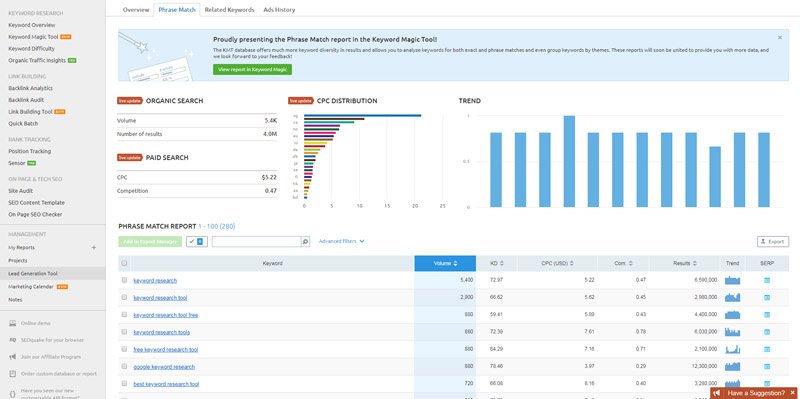Introduction
If you’re someone who monitors your website’s performance carefully and wonders why your great content can’t be found on Page 1 of Google’s search results pages (SERP), you’re not alone.
There’s nothing worse than taking the time to create valuable content if it doesn’t get to the people who need to see it the most. This is a conundrum that not only frustrates content creators but can leave even the most seasoned of marketers teeming as they glare with envy at that elusive top spot on the SERP.
So, what do you need to change? Well, if you’ve come across the phrase ‘keyword research’ before, you’ll know just how important it is for search engine optimisation.
However, keyword research is like prospecting for oil: it’s riches for those who hit the keyword jackpot but it can be frustrating and difficult for others. Luckily, the simple steps that we outline in this post will help get you and your business on course for the very top (of Google’s rankings, that is).
In this post, we’ll break down seven of the most crucial long tail keyword research techniques to help your website achieve a higher ranking on Google and get your content seen by more people, more of the time.
Here’s a quick snapshot of our seven steps:
- Brainstorm Pillar Keywords
- Use the Best Keyword Research Tool on the Market
- Use Google to Check for Alternatives
- Expand Pillar Keyword into Long Tail Keyword Phrases
- Choosing Your Long Tail Keyword
- Optimise Your Content Using Long Tail Keyword
- Link Your Cluster Content to Your Pillar Content
1. Brainstorm Pillar Keywords
This can often be one of the most under-appreciated steps for generating ideas.
Your pillar keyword is the phrase all of your supporting content will be anchored around. A pillar keyword is normally an aspirational short-tail keyword which you want to rank for with a high number of monthly searches. From this main keyword you can create related long tail keywords that link to your pillar, all of which provides great SEO value for your target pillar keyword.
If you’re planning to create five blog posts about a certain subject but you aren’t sure what topic to choose, then brainstorm. Try to come up with a list of at least ten topics to build your content around. Consult various departments of your business to help generate ideas and questions that your content can help to answer.
It’s absolutely critical that you give this portion of the content creation process enough time to utilise the correct topic before you go in depth around what keyword to use. Your pillar keyword is the phrase that all of your content will be focused on so it is of paramount importance that you identify a strong pillar in order to generate enough long tail keywords for all of your content.
Once you have your list of pillar keywords, it is time for step two of the process.
2. Use the Best Keyword Research Tool on the Market
There are many keyword research tools on the market and we have tried and tested all of them. In our opinion, SEMrush is amongst the best for uncovering those hard to find keywords that can help you see your content make it to the top of Google’s SERP.
If you aren’t already aware of SEMrush, it’s a brilliant toolkit for monitoring and analysing all of your SEO concerns. SEMrush has a Keyword Research tool where you can search the keywords that you brainstormed in the first step and analyse all of the SERP data provided - and it’s a lot of data. Don’t be overwhelmed, though. SEMrush has great training videos and courses to help you get to grips with all of their tools.
Here’s a snippet of what their Keyword Research tool provides you with:

As you can see, if we were to use the phrase ‘keyword research’ for our chosen keyword, we would find all the relevant data surrounding that phrase, including the volume of searches over the past 12 months, the cost per click (CPC) and the number of URL results that appear as in Google.
Using SEMrush along with your brainstormed pillar keywords, you can uncover your optimal keywords - those being keywords that have a high volume of searches over the past 12 months but also possess a relatively low number of results when searched.
In this example, it is evident that the phrase ‘keyword research tool’ has the second highest volume of searches over the last 12 months and yet, out of the top four in its category, possesses the lowest number of results. If you were looking to create a piece of content about keyword research, using the term ‘keyword research tool’ might be a good choice considering these results.
That being said, if you’re interested in uncovering the perfect long tail keyword for your content, you wouldn’t hang your keyword research hat only at SEMrush’s door.
3. Use Google to Check for Alternatives
This step is one that many miss but, when you think about it, makes perfect sense. When optimising your content for Google’s results page, no matter how many SEO research tools you utilise, there’s no better way to assess the landscape of the page on which you want your website to appear than by Googling it yourself.
SEMrush does have an option to preview the page from which their data is pulled but it can often be the case that this is not the most up to date information. It is always worth Googling your chosen keyword to take a more recent reading of the number of search results that appear.
This technique can also be useful to observe what similar content is already out there and the word count of each result. By knowing what content you are competing against, you can better optimise your own in order to provide a more specific solution that your competitors may have overlooked.
Not only could this technique alert you to your competitor’s content but it can be a great way to check for alternative keywords that can be utilised.

As you can see, when searching ‘keyword research’ in Google, we are provided a number of keywords that are related to that topic. This can be a great research technique to expand on your pool of potential keywords and create a more optimised piece of content that will appear higher on Google’s search results page.
4. Expand Pillar Keyword into Long Tail Keyword Phrases
Now the research steps are complete, it is time to expand your pillar keyword into a long tail keyword phrase in order to target a specific niche with your content. You could create five blog posts all around your pillar keyword but how diverse and useful would each of them really be when read together?

By narrowing the focus for each of your individual pieces of content that support your pillar keyword, you will find yourself using keywords that look to solve a very specific problem. While making your content more valuable, this technique also has the added benefit of ensuring that the majority of the visitors to your site’s content are more likely to be struggling with that explicit problem.
If you don’t expand your pillar to a long tail keyword and your topic is too broad, you’ll find that, not only is the competition for ranking much higher, but you also can’t be sure that the website traffic you are gaining will find your content useful. Evidence of this might be seen through a high bounce rate. Visitors are searching to solve a specific problem and, if your only concern is gaining a higher ranking for a well-searched pillar keyword, your content, and the time it took you to create it, could be wasted.
As you should have done in the first brainstorm, try to generate at least ten long tail variations of your pillar keyword that pertain to a specific challenge your readers are facing. It is a good idea to create a spreadsheet for all of your brainstormed pillar and long tail keywords to keep track of any keywords you use in your content. This way, you can be sure that your content is diverse enough and that each piece is solving a specific problem so you don’t end up repeating yourself.
Once you have enough options to begin creating your content, it is time for the next step.
5. Choosing Your Long Tail Keyword
If you spent enough time brainstorming, you will have selected a strong enough pillar keyword that supports all of the individual pieces of content you plan to create. You will also have generated a number of long tail keywords that are specific enough to accurately answer a question that your visitors might have. It is now time to narrow the focus.
Keyword Research in the Age of RankBrain https://t.co/95cBmWY7aS pic.twitter.com/jeylBANhCE
— Growth Hacking (@0MGWV) May 14, 2018
When selecting a topic to write about, you should ensure that the long tail keyword is accurate enough for what your content will cover. There’s little more frustrating than searching to solve a problem, finding a piece of content that looks like it might help but discovering hardly any useful information. If you aren’t able to provide valuable information for your visitors then you might want to question why it is that you are creating content for that long tail keyword phrase.
Furthermore, you should ensure that the pillar and long tail keywords are relevant to your industry. When searching for solutions, your prospective visitors will be looking for industry experts and leaders. Why would they read an article from a recruitment agency to learn tips about choosing the perfect wedding dress. No matter how high you appear on your chosen search engine results page, if you’re in the wrong business, you’ll stick out like a sore thumb(nail).
6. Optimise Your Content Using Long Tail Keyword
Here’s where we start to get into more depth about the workings of the search engine results page and its algorithms. When crawling your website’s content, Google’s algorithm looks to identify the nature of your content from what you provide and its relevance to the search results.

Optimising content, both in terms of words and format, is crucial for SEO. A poorly formatted blog post just won’t be read, no matter how great the words. By including your long tail keyword throughout your blog post, you stand a much better chance of ranking highly for that keyword.
We recommend that you include your long tail keyword in the headings and subheadings of the post. This technique is a great way to let Google know that you’re blog post is focused on that topic as well as allowing the reader to quickly pick out the relevant information from the headings. Just be careful not to stuff every one of your headings with keywords and make sure your writing feels natural. If a keyword doesn’t belong in a heading or subheading, don’t force it in.
Including the long tail keyword in the introduction as well as the conclusion is also a great way of gaining a boost from Google’s algorithm. Place the keywords in the first and last paragraph of your post to help nudge Google along while it finds a ranking for your content.
The optimisation of your long tail keyword doesn’t stop there, though. Be sure to include your main keywords in the blog post title and its meta description. In order to help out anyone searching for relevant content around that keyword, provide them with a clear and concise preview of what your content is all about.
7. Link Your Cluster Content to Your Pillar Content
Another aspect of Google’s algorithm is that it takes into account your internal links as well as your external backlinks when deciding where to place you in the results.

By creating a physically linked network of cluster content around your pillar content, you are telling Google ‘hey, these are all related topics and we are the experts on this topic’. Taking the time to carefully place your links, and letting Google know you are an expert in a topic, will support your content on its journey to the top of the SERPs.
Supporting a broad pillar keyword with clustered content that is focused on specific long tail keywords is a tried and tested technique to help achieve a higher placing on a search engine’s results page. It will also help visitors to navigate your website to find the most useful information for their needs. Better user experience means a longer dwell time which means better SEO.
You can read more in our article about topic clusters and how they improve SEO in our recent article by clicking on the link.
Conclusion
Now that you’ve read our seven steps to use long tail keywords to help boost your website traffic, you’ll notice that you start to place higher on search engine results page and create content that targets specific visitors. You’ll see more valuable traffic to your site in no time!
To learn more about how to get the most out of your content through SEO, book a Free Marketing Assessment with one of our team today.




